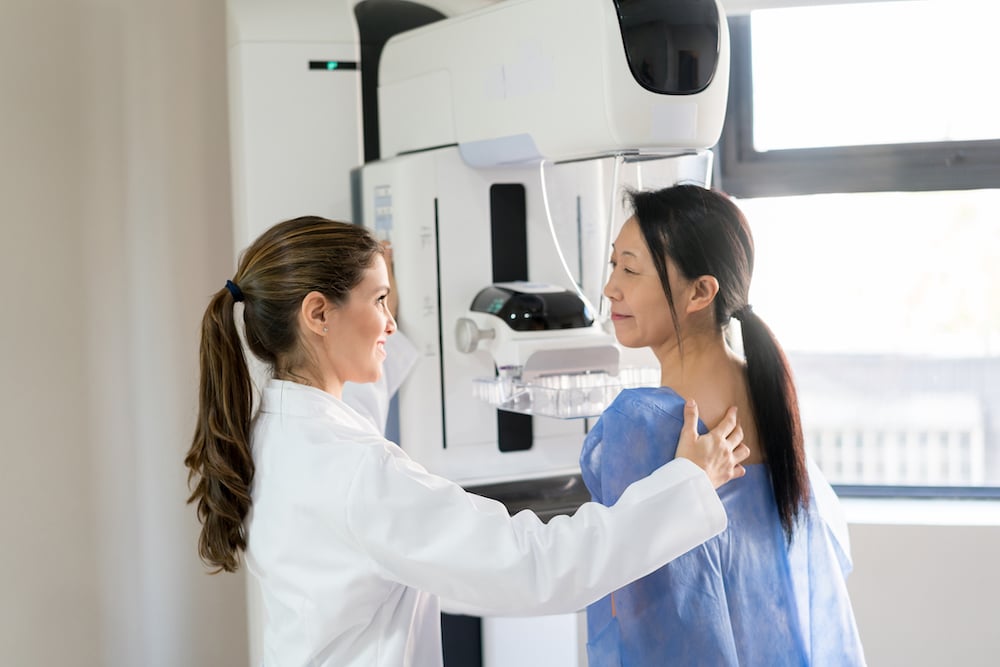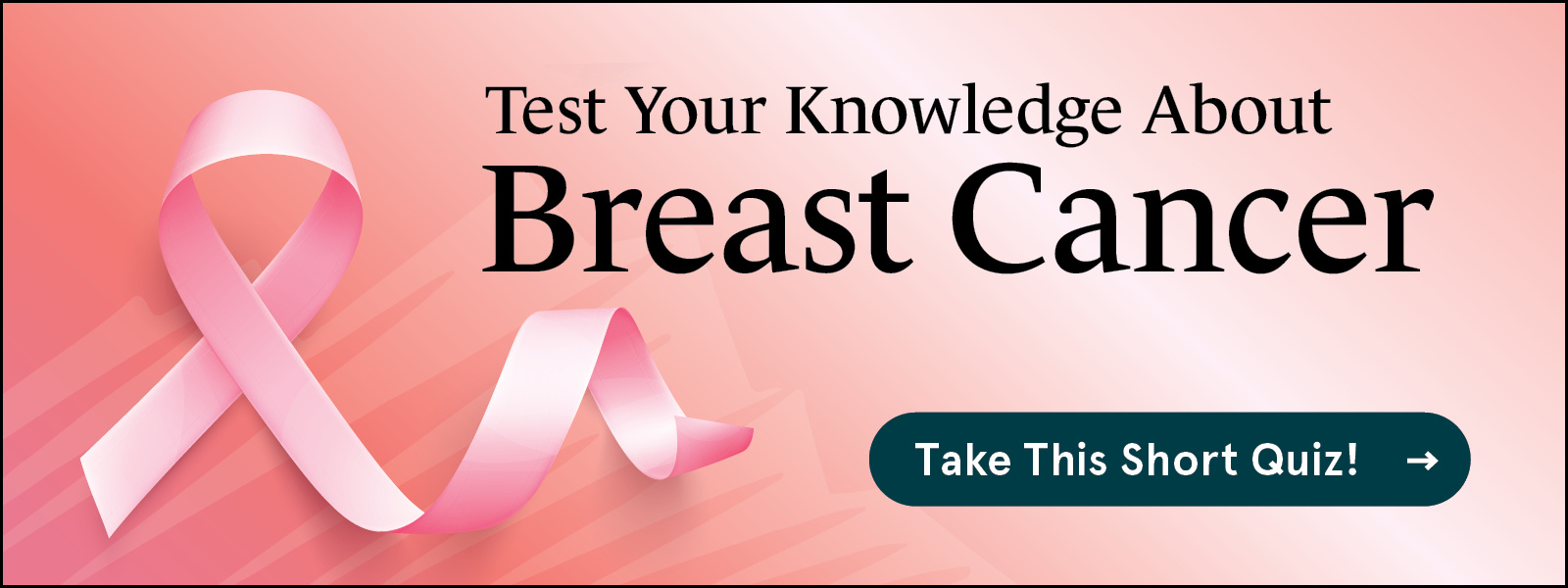What You Should Know About the Types of Breast Cancer Screening
6 min read

Most women don’t experience signs or symptoms of a tumor developing in their breasts. Fortunately, breast cancer screening is widely available, making it possible to detect breast cancer when it’s small, usually before it can be felt.
Breast cancer screening tests are images of the inside of the breast. Most likely, you’ve heard of a screening mammogram. This x-ray image allows the radiologist to see if there are any abnormal areas in each breast that should be reviewed further.
But did you know that breast cancer screening for women at a higher risk level can include more than a mammogram?
Breast Cancer Screening Recommendations
Typically, a woman’s breast cancer risk level, which can be average or high, helps guide when she should begin breast cancer screening. To assist in determining breast cancer risk, the American College of Radiology (ACR) and Society of Breast Imaging (SBI) now recommend that all women undergo a risk assessment starting at age 25.
If you are between 25 and 40 and have not yet talked to your gynecologist or your primary care physician about your personal level of risk for developing breast cancer, be sure you make this part of your next appointment.
For Those at Average Risk of Developing Breast Cancer
A woman who is at average risk has no personal history of breast cancer, no strong family history of breast cancer, or no known inherited genetic mutation (BRCA-1 or BRCA-2).
For this category, the ACR recommends women have an annual mammogram starting at age 40 with no upper age limit as long as the woman is healthy enough to accept treatments.
Breast Cancer Screening for Those at High Risk
You only need one of the following to be at an increased risk of developing breast cancer:
- Strong family history of breast cancer
- Having dense breast tissue
- Inherited BRCA1 or BRCA2 gene mutations
- Exposure to chest radiation before age 30
Your doctor may have you complete a breast cancer risk questionnaire to identify your lifetime risk. If the results show a lifetime risk of 20-25% or greater, you are likely to follow the high-risk screening process.
Annual mammograms can begin between the ages of 25 and 40, depending on the individual risk type. Breast MRIs can start as early as age 25 for high-risk patients. If a breast MRI is not available, a contrast-enhanced mammogram may be recommended.
Your doctor will discuss your breast cancer risk and help you determine the right time to start breast cancer screenings.
How Physicians Screen for Breast Cancer
Mammograms are the primary tool for breast cancer screening, with breast ultrasounds and MRIs used for some patients as needed.
Screening Mammograms
A mammogram is an X-ray picture of tissues inside the breast. Mammograms are the most common type of screening test used for detecting breast cancer. They can detect changes in the breast before they are physically noticeable, such as lumps or calcium deposits called microcalcifications. Lumps or microcalcifications can be from cancer, precancerous cells, or other non-cancerous conditions.
Several types of mammograms are available:
- Film Mammography. This procedure uses X-rays to look for changes in breast tissue. It is the standard type of mammography used for screening.
- Digital Mammography. Similar to film mammography, this screening uses a computer instead of X-rays to take digital photos of the breast. Women with dense breast tissue may benefit from digital mammograms as they can produce better images than film mammograms.
- 2-Dimensional Mammography. A 2D mammogram creates a 2D image of each breast using two X-ray images of each breast.
- Digital Breast Tomosynthesis. Also known as 3D mammography, this method takes a series of X-rays of the breast from different angles and then creates a 3D image of the breast. The clearer images reduce the need to repeat the mammogram for many patients.
The American Cancer Society recommends both 2D and 3D forms of mammograms for breast cancer screening. They also recommend using the type that your doctor recommends. In case your mammogram report indicates any abnormality in your breast, further tests will be required to determine whether it is cancer or not.
Related Blog: A Guide to Your First Mammogram
Breast Ultrasound
Breast ultrasound is a non-invasive imaging method that uses sound waves to create pictures of the inside of the breast. It can help detect certain breast changes, such as cysts, which are difficult to identify on mammograms. It can also help determine whether a mass is solid or fluid-filled. Although ultrasound is not typically used as part of routine screening for breast cancer, it can be a secondary screening tool for women with dense breast tissue who have had an abnormal area detected on a mammogram.
Breast Magnetic Resonance Imaging (MRI)
A breast MRI uses radio waves and magnets to produce images that a mammogram cannot typically see. MRI is a more sensitive imaging tool that looks at breast tissue differently than other imaging methods. Because of this heightened sensitivity, MRIs may also pick up more benign (noncancerous) abnormalities than conventional screening.
Breast MRI is not standard for screening average-risk women. However, it may be used as an additional screening method for women who are considered high-risk for breast cancer.
Something Was Found During Breast Cancer Screening, Now What?
First, it’s important to know that every abnormality found through breast cancer screening is not cancer. There are many non-cancerous conditions found through breast cancer screening. If something out of the ordinary is found, your doctor will recommend additional testing, which may include a biopsy.
Read more about breast biopsy in our blog, Understanding Your Breast Cancer Pathology Report.
If cancer is detected, it’s likely to be at an early stage when treatments produce the best results. It can quite literally save your life or the life of someone you love.
Rocky Mountain Breast Specialists Encourage Routine Breast Cancer Screening
It's essential to keep track of your breast health. In addition to regular screening, it’s helpful to perform self-exams. No one knows your breasts better than you, so make sure to check for any changes or abnormalities regularly.
Discuss your risk level and breast cancer screening plan with your primary care physician or gynecologist. They will help you determine which screening is best for you based on your individual risk factors and the timing.
If the results of your screenings and additional tests reveal a cancer diagnosis, the breast cancer specialists at Rocky Mountain Cancer Centers are available to assist you. Schedule a consultation at one of our locations throughout Colorado, including the Denver area, Colorado Springs, Boulder, and throughout the Front Range.
